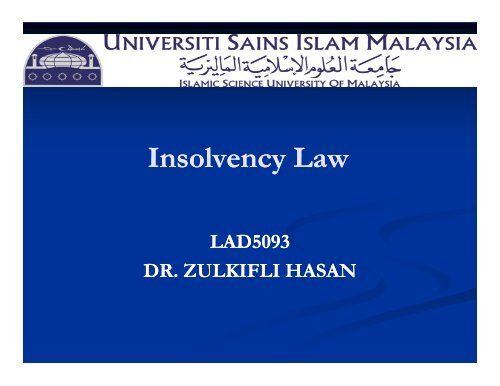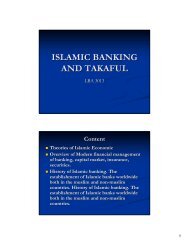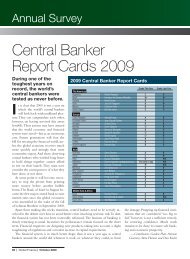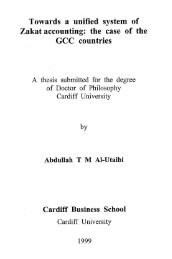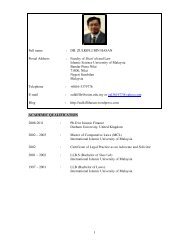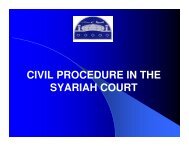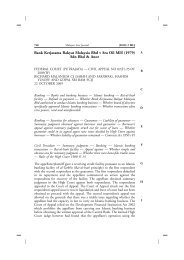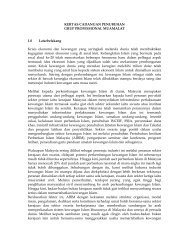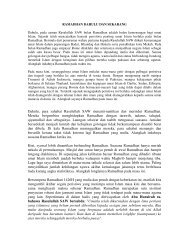Winding-up and Bankruptcy
Winding-up and Bankruptcy
Winding-up and Bankruptcy
Create successful ePaper yourself
Turn your PDF publications into a flip-book with our unique Google optimized e-Paper software.
Insolvency Law<br />
LAD5093<br />
DR. ZULKIFLI HASAN
Bankr<strong>up</strong>tcy<br />
<strong>Winding</strong>-<strong>up</strong><br />
CONTENTS
Introduction<br />
Insolvency law is concerned with<br />
companies <strong>and</strong> individuals who are debtors<br />
<strong>and</strong> who are unable to repay their debts.<br />
Personal Insolvency<br />
Corporate Insolvency
Relevant Laws<br />
Bankr<strong>up</strong>tcy Act 1967<br />
Bankr<strong>up</strong>tcy Rules 1969<br />
Companies Act 1965<br />
Companies (<strong>Winding</strong>-<strong>up</strong>) Rules 1972
What is bankr<strong>up</strong>tcy?<br />
Bankr<strong>up</strong>tcy is a process where a debtor is<br />
declared a bankr<strong>up</strong>t pursuant to an Adjudication<br />
Order made by the High Court against the<br />
debtor if he is unable to pay his debts of at least<br />
RM30,000.00.
Who is a debtor?<br />
A debtor is a person subject to the bankr<strong>up</strong>tcy<br />
jurisdiction of the court under S 3(3) of the Bankr<strong>up</strong>tcy<br />
Act 1967, <strong>and</strong> at the time the act of bankr<strong>up</strong>tcy is<br />
committed:<br />
Was personally present in Malaysia; or<br />
Ordinarily resided or had a place of residence in<br />
Malaysia; or<br />
Was carrying on business in Malaysia either personally<br />
or by means of an agent; or<br />
Was a member of a firm of partnership which was<br />
carrying on business in Malaysia.
How?<br />
The High Court makes a Receiving Order <strong>and</strong><br />
Adjudication Order after a bankr<strong>up</strong>tcy petition<br />
has been presented.<br />
1. Creditor’s petition<br />
2. Debtor’s Petition
Creditor’s Petition<br />
<br />
<br />
An act of bankr<strong>up</strong>tcy (S 3(1) of the BA 1967) by the D must have<br />
taken place within 6 months prior to the presentation.<br />
BN against the debtor:<br />
Is domiciled in Malaysia; or<br />
Within 1 year b4 the date of the presentation of the petition has:<br />
Ordinarily resided in Malaysia; or<br />
Had a dwelling house in Malaysia; or<br />
Had a place of business in Malaysia; or<br />
Carried on business in Malaysia personally or by means of an<br />
agent; or<br />
Is, or has been within 1 year before the date of the<br />
presentation of the petition, a member of a firm or<br />
partnership which has carried on business in Malaysia by<br />
means of a partner or partners or an agent or manager.
Debtor’s Petition<br />
A DP is by itself an act of bankr<strong>up</strong>tcy.<br />
To make himself a bankr<strong>up</strong>t in order to protect himself from his<br />
creditors’ claim.<br />
No requirement that a minimum amount of debt must be owed<br />
before a debtor’s petition can be presented. After its presentation, a<br />
debtor’s petition cannot be withdrawn without the leave of the<br />
court.<br />
The petition (Form 3 of Bankr<strong>up</strong>tcy Rules 1969) is to be filed at the<br />
court of the State in which the debtor resides. Deposit with the<br />
DGI RM1,500.00.<br />
The court will not accept the petition for filing unless the receipt of<br />
the DGI for the deposit is produced. A sealed copy of the debtor’s<br />
petition must then be served on the DGI by post.<br />
On the hearing of the debtor’s petition, the Court will make a<br />
Receiving Order as well as an Adjudication Order.
Factors to Consider<br />
In monetary claims, JD is the person against whom the<br />
judgment or order is made or given.<br />
To consider if it is worth to commence a bankr<strong>up</strong>tcy<br />
action.<br />
The total judgment debt must be more than<br />
RM30,000.00.<br />
Where the judgment debtor has not complied with the<br />
judgment or order made, may commence bankr<strong>up</strong>tcy<br />
proceedings against the judgment debtor to recover the<br />
same.
Cont…<br />
Judgment debtor could be in debt to several<br />
other individuals or companies.<br />
Once a debtor has been adjudged a bankr<strong>up</strong>t,<br />
other creditors will file in the Proof of Debt<br />
form <strong>and</strong> Proxy to be entitled to share in any<br />
distribution from the estate of the bankr<strong>up</strong>t.<br />
The distribution of the estate is according to the<br />
priority of the creditors' claim.
Bankr<strong>up</strong>tcy Rules 1969<br />
Bankr<strong>up</strong>tcy Proceedings<br />
1. Judgment Serve to Debtor<br />
2. BN & Request to Issue BN<br />
BN valid for 3 months @ 90 days<br />
7 days notice in BN<br />
Serve to the JD by personal service by h<strong>and</strong> @<br />
substituted service<br />
3. Filing Affidavit of Service of the BN<br />
4. Filing Creditors Petition & Affidavit verifying the<br />
Petition<br />
Must be filed within 6 months from the date of filing BN
Cont..<br />
5. Serve to Insolvency Department<br />
RM2,000-00 deposit<br />
Copy of sealed Judgment;<br />
Copy of BN <strong>and</strong> Request to issue BN<br />
Copy of Affidavit of Service BN<br />
Copy of Creditors Petition & Affidavit verifying<br />
the Petition<br />
6. Serve Creditors Petition & Affidavit<br />
verifying the Petition to the JD
Cont..<br />
7. 3 days b4 hearing of CP – Petitioner must serve to DGI:<br />
Original sealed Judgment; Original BN, Copy of Request to<br />
issue BN, Copy of Affidavit of Service BN, Original CP,<br />
Copy of Affidavit verifying the Petition <strong>and</strong> all<br />
other<br />
pleadings <strong>and</strong> cause paper such as copy of Affidavit of<br />
Service<br />
8. Hearing of CP before Registrar<br />
<br />
Hearing will not be heard until the expiration of 8 days<br />
from the service of CP to the JD<br />
JD is allowed to file Notice of intention to show cause<br />
9. Registrar will issue Adjudication Order <strong>and</strong> Receiving<br />
Order (Perintah<br />
Penghukuman & Perintah Penerimaan)
Restrictions<br />
Restriction to go abroad,<br />
Acting as a director,<br />
Carrying on business <strong>and</strong> requirement to<br />
contribute to your bankr<strong>up</strong>tcy estate regularly<br />
for the benefit of the creditors.<br />
To give <strong>up</strong> assets including your home <strong>and</strong> cars.<br />
There is no automatic discharge from<br />
bankr<strong>up</strong>tcy in Malaysia. May be discharged<br />
either by the Court or the DGI subject to any<br />
creditor’s objection.
<strong>Winding</strong>-Up<br />
<strong>Winding</strong> <strong>up</strong> is also known as "liquidation".<br />
Where a company cannot pay its debt as <strong>and</strong> when<br />
it falls due, a company is insolvent.<br />
<strong>Winding</strong> <strong>up</strong> means where under the companies<br />
law, an insolvent company in order to discharge its<br />
liabilities, the control of the company's affairs will<br />
be undertaken by a form of external<br />
administration under a person called a "liquidator"<br />
who will prepare for the company's dissolution.
Corporate Insolvency<br />
The CA 1965 S 218(2): a company shall be deemed<br />
insolvent if a creditor to whom a company owes more<br />
than RM$500.00 <strong>and</strong> such sum is due for payment,<br />
serves a written notice is given or to secure or<br />
compound such sum to the satisfaction of the creditor.<br />
A company that is insolvent will cease business <strong>and</strong> go<br />
into liquidation after being wound <strong>up</strong> by the Court.<br />
The company will be struck-off from the register of<br />
companies <strong>and</strong> the assets of the company will be<br />
liquidated or sold off. The proceeds of sales will be<br />
distributed according to law.
Modes of <strong>Winding</strong>-<strong>up</strong><br />
<strong>Winding</strong> <strong>up</strong> of a company is the process whereby its life<br />
is ended <strong>and</strong> its property administered for the benefit of<br />
its creditors <strong>and</strong> members.<br />
Modes of <strong>Winding</strong> <strong>up</strong> -<br />
(I) compulsory winding <strong>up</strong> ie., by Court (s 218)<br />
(Ii) voluntary winding <strong>up</strong>; (s 254)
<strong>Winding</strong>-<strong>up</strong> Procedure<br />
Companies (<strong>Winding</strong>-<strong>up</strong> Rules) 1972de<br />
1. Issue of Statutory Notice of Dem<strong>and</strong><br />
2. lapse of 3 weeks <strong>and</strong> no payment made<br />
3. <strong>Winding</strong>-<strong>up</strong> Petition Form 2<br />
4. File Affidavit in F7 to verify the petititon<br />
5. service of petition <strong>and</strong> affidavit<br />
6. file affidavit of service
Cont…<br />
7. to advertise in 2 local dailies twice 7 clear days b4<br />
hearing<br />
8. File of affidavit of compliance<br />
9. Petitioner/Solicitor to appear on hearing date<br />
10. Debtor may oppose the petition by filing <strong>and</strong><br />
servicing affidavit in opposition (AIO) 7 days b4<br />
hearing<br />
11. Petitioner may file <strong>and</strong> serve affidavit in reply<br />
within 3 days <strong>up</strong>on receipt of AIO.
Cont…<br />
12. any person who intends to appear during<br />
hearing, must file notice of intention to appear F8<br />
13. The ct may dismiss the petition or grant an<br />
order.<br />
14. Notice of winding-<strong>up</strong> must be gazzetted <strong>and</strong><br />
advertized in F 12<br />
15. Service of the notice on appointed liquidator or<br />
CCM, debtor. Must inform the liquidator in F10<br />
within 14 days of the order.


